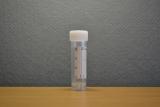Test Directory
Corneal scrapings - Routine M, C & S
Containers - Adult

Agar Plates
|
|

Slides
|
|

Slide Format
|
|

Sterile Universal 20ml
|
|
Containers - Child

Sterile Universal/Culture Plates
|
Volume Range
As adult |

Slides
|
|
Laboratory Site
Old Dalkeith Road
Edinburgh
EH16 4SA
Howden
Livingston
West Lothian
EH54 6PP
Transport arrangements
Transport as soon as is practicable.
Sample storage arrangements
If delay in transporting, store at room temperature.
Special instructions for collection
Useful: in patients where bacterial or fungal or acanthamoebic keratitis is suspected. Keratitis, where the cornea is inflamed, is a serious condition which may progress to perforation and blindness if treatment is unsuccessful. Pre-disposing factors include topical corticosteroid use, and contact lens use, or prior ocular disease.
Collection: These should be collected by an ophthalmic surgeon. Due to the small amount of material collected, sample best inoculated at the bedside so culture plates and slides are available at Princess Alexandra Eye Pavillion for samples coming to the RIE and from the Bacteriology lab at SJH for samples from SJH. If using a slide, mark the slide with a pen circle around the sample, and the patients details as shown above. Innoculate the surface of the agar; if the syringe needle is dug deep into the agar this will delay signs of bacterial growth.
See document about collection of corneal scrapings.
How to request
Via Trak ("C&S - Tissue" then specify sample site e.g. 'Eye,Rt') or request form.
Availability
24 hours (RIE), 0900-1700 (SJH)
Anticipated turnaround
Up to 5 days
What happens if the result is positive or abnormal
Telephoned by microbiologist.
General additional information
If wishing for Acanthamoeba investigation, it needs to go in special transport medium available at PAEP, and it is sent direct to the Glasgow Reference Lab from the requester and not via the laboratory at RIE.